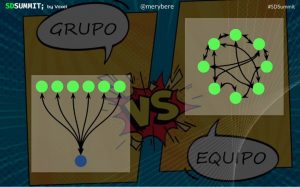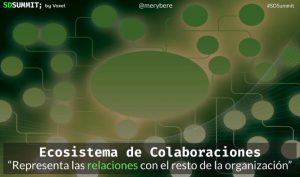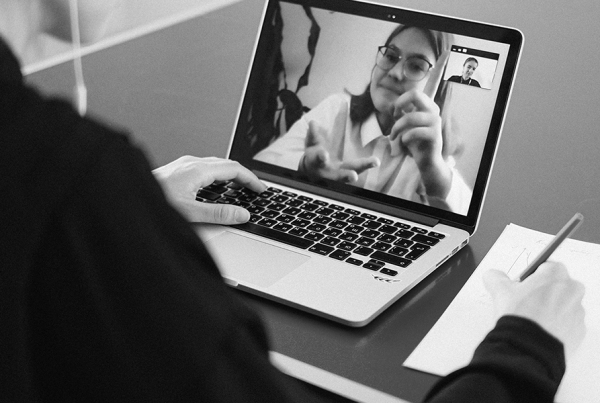María Berenguer (@merybere) is an Agile Mentor & Practitioner, and in the talk she prepared for the SDSummit she talked us about her experience working with transversal teams, using the chaos theory as a reference to design multiple tools that will help those teams to contribute with the maximum value possible.
An interesting introduction

María starts talking us about the Lorenz Attractor, a chaotic system diagram, that leads us to the origin of the butterfly effect, from which we maybe remember the saying that goes “The flap of a butterfly’s wings in Hong Kong can cause a tornado in New York”
She explains us a little more: Edward Lorenz was conducting a study about climatology at his office, and then when he arrived at home, decided to execute a last simulation, and surprisingly, even though using the same parameters, he obtained completely different results, what had happened?. The input data that Lorenz used at home had a precision of only three decimals, as opposed to the data he used at his office, which had more precision digits. Nevertheless, this insignificant difference (of ten thousandths) had resulted in totally different (opposite results even) on the output data.
The chaos theory at organizations
So, ¿how all of this relates to technical teams?. The chaos theory tells us that the world has chaotic effects that generate constant randomness on results, and organizations are ruled by the same effects. This means, the processes that generate our deliverable value, depend on multiple factors, and a minimal variation on any point of these processes, can generate a great impact in the deliverable value’s quality.
We have to understand organizations as a set of gears interacting with each other, the right interaction between them depends on multiple factors, a lot of them uncertain, and a lot of them human, and this is where we introduce the first point of chaos. This interaction or articulation will always be affected by the behaviour that each team adopts in every moment.
Transversal teams and their purpose
There are teams that are not tasked with the development of a specific product or that do not provide an end user service, but instead provide services to internal customers. These are the transversal teams, which impact the organization on several points, favoring the organization’s good performance and articulation, even though they don’t directly deliver to the end user.
We then ask ourselves the following questions: do transversal teams know which its purpose is?, which is their mission inside the organization?, do they really know it?. And this is the moment when the facilitators can bring light to the process.
María proposes an exercise to seek some answers to the posed questions. It begins reflecting on the team purpose inside the organization: they are not a product team, but instead they provide an internal service… with this premise the following questions can be asked:
- Who uses this team’s products or services?
- Which are the key objectives? How does the organization benefit from the team’s service?
- Why is this team and its provided services needed? Which are these essential services?
Every team member should reflect individually about these questions, and then they share thoughts. This is a way to avoid influencing individual opinions and will produce more diverse ideas. As a result we will have clearer concepts to continue working on the team’s mission.
At this point, it’s possible that some irregularities are observed (predominant voices, or people that await confirmation to give an opinion), in order to obtain more information, we can raise the following question: Are you a group or a team?
The question about the group or the team

This question normally confuses them… Are you a group or a team?, there is usually no immediate answer, or maybe there is no answer at all, they take it for granted that they are a team, they haven’t even questioned that concept before!… and what’s the difference anyway?
At this point, María proposes another dynamic to discover it:
- We ask them to, individually, define the qualities of the people they are working with
- We then select the sentences that define a group or a team from different perspectives, and distribute them in the wall on individual cards, in no particular order
- Then, we ask them to observe and read the cards in silence, as it was a visit to the museum, and then point out the ones they identify with
- They are asked to vote, without limit, the cards they like the most, and then they are asked to debate on the most voted ones
- In this moment we identify each card and move them to their belonging are of Group or Team, and discuss further if needed
The goal of this dynamic is not to put a name to this collection of persons working together, but it really doesn’t matter, what does matter is that this collection of people understand and be aware of what their structure is, and how they work, and that there are more definitions than self-organized team. This way they will get to know each other better, and from there they will know how to improve.
We can summarize the definition of groups and teams as:
Grupo
|
Equipo
|
Whether they are not self-organized, or don’t have group dynamics, or split and attend tasks individually, this is fine!. At the end, they discover they don’t have to behave as a product team, the transversal team can have its own way of doing things, beyond having “the right name”, what is really important is to know what is their reason of being inside the organization, and as facilitators we must guide them and help them through this discovery, first, of their purpose, and then, of their objectives and concrete initiatives. It’s becoming increasingly clearer where they can positively impact on the organization’s system!
The organization as an ecosystem
“Teams depend on each other to provide value aligned to the enterprise’s vision”
It’s true that each team has his own concrete strategy, but when they implement this strategy, it’s certain that they will need other people or teams to help or collaborate. Some of these interactions can be foreseen, but other ones can not… and this is when we introduce another point of chaos.
As guides or facilitators it’s important to visualize all the team’s information we’ve got, and for this María suggests us the Collaboration Ecosystem, a dynamic we can develop as follows:
- The team members, in small groups, draw the interactions with other people or teams in the organization
- The different visibilizations are shared
- The team chooses the visibilization that is more suitable for them
It may happen that the team draws itself bigger and in the center of the ecosystem, if this is the case we should ask why this has happened: it’s because it’s graphically convenient?, are they really seeing themselves in the center of it? Is this a point of view related to the way they provide value?

To further enrich our knowledge about how the team works as part of the ecosystem, we are going to identify how the relationships with other ecosystem entities work, which entity makes the desicions?. It may be that sometimes the team has the last word, that sometimes the team can only be an attendant, and maybe sometimes it doesn’t even participate at all.
We can interpret this collaboration map as a set of alliances towards a common goal, and like in a Risk game, we can identify where can we have more influence, where are we going to face more resistance, where do we have to intervene, where do we become more exhausted or where will we be more successful. In this moment, the next point of chaos is introduced by people (again). How are they going to react to each of our actions?
The more visible this strategic map is, the easier will be to hit the mark!
In order to give shape to this tool María uses management 3.0’s delegation poker cards, adapted to the concepts we are interested in, and through them, be able to analyze where the decision making is happening, visualizing a global strategy.
“Having a global vision of the system is essential to reduce to the minimum all of this chaos, or at least, to be able to throw that flying butterfly on the right direction, so it achieves the maximum impact on the system”
Resourcefulness when designing a facilitation
To be able to get the most of these sessions, it requires a lot of experience, customization, material and tools preparation, alternative options, timeboxes, checkpoints… and, nevertheless, there will always be a moment you will have to improvise. If we invoke the fourth agile value, it is better to have the capacity to break the script we prepared, and instead adapt to a change when the team needs it.
And from here on, it’s up to you!, it’s the team that must walk the path laid out by the recently discovered strategy, and turn their actions into something of great impact.
A last consideration
We must understand the objective of the system we are part of, and also the team’s objective. Even though not all the teams have the same mission, all the teams have a mission,but frequently it’s not entirely clear.
It’s possible that product teams get to know their mission easily, since there are more proven tools out there. Nevertheless, when talking about transversal teams there is a lot to try yet!… We have to get to know them well so they are able to surf the chaos and generate great impact on the organization
Wrapping up…
“A small change from the team can generate great impact on the system”
I’ve enjoyed María’s talk a lot! She has shown us a very interesting perspective, with a lot of possibilities, using chaos theory as a starting point, to identify where a transversal team can provide the maximum to the organization it belongs to. We’ve seen a lot of tools she herself has designed and as she tells us, in this field (of transversal teams) there is a lot left to be investigated, to help those teams achieve that maximum impact.
You can find her talk on youtube, I invite you to watch it, it’s highly advisable!
Thank you very much María!
About the autor:










